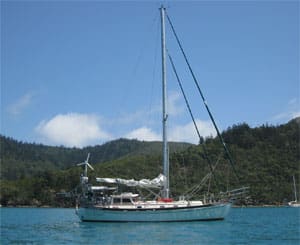Thanks to an early introduction to the books of Eric Hiscock, the primary item on my bucket list has always been circumnavigating in my own boat at least once. As retirement approached, I started shopping for the right boat for that adventure.
There were quite a few production designs on the market that met my requirements: attached rudder, long enough keel for good tracking, and enough displacement that a few cases of beer would not slow it down. As my shopping progressed, I eventually found myself gravitating toward pilothouse boats. The idea of having a comfy, dry place to stand long watches was very appealing.
There were not many choices in the 40-foot range, and I quickly landed on the Bob Perry-designed Tayana 37. Most Tayana 37s were built with conventional cockpits but about 10 percent had pilothouses, and the pilothouse did not look like a poorly thought-out add-on.
Layout
I am amazed at how many experienced sailors who come aboard my Tayana 37, Active Transport, are surprised at the way in which the pilothouse is incorporated into the deck and cabin.
If you look at the boat from the dock, the pilothouse looks sort of like a massive hard dodger. It’s not obvious that the sole of the pilothouse is about 20 inches lower than the cockpit sole.
There are two steps down into the pilothouse and two more steps covering the 20 additional inches down to the main cabin sole. This arrangement is much more convenient than a ladder, which would typically be made very steep to minimize the room it takes up in the cabin.
The pilothouse on my boat has a navigation station to port and a second steering station to starboard. The height of the pilothouse above the main cabin top is much less than most of the dodgers I see on boats with the full-size aft cockpit.
Pilothouse benefits
Comfort: The primary feature I was after when I chose a pilothouse boat was comfort. It turns out there were a lot of additional benefits, but comfort was what I was focused on, and the pilothouse configuration delivered plenty of comfort. The seats in the pilothouse provide a warm, dry place to stand watch either day or night.
The pilothouse also added a lot of comfort during the brief summer we spent in Prince William Sound in Alaska. Even in the summer it’s chilly up there, especially at night. The pilothouse provided a great way to visually check on the boat’s position at anchor and provided a nice comfy “blind” for watching wildlife, especially at dawn. Moving around the sound was also more comfortable inside when the spray started flying.
Reduced sun exposure: Being Irish, I’m part of a highly evolved subset of humanity. After thousands of years of selective pressure, we have ended up being very well adapted for living in pubs. That adaptation does not leave us well suited for life in the tropical sunshine.
A pilothouse boat allows you to stand watch out of direct sunlight most of the time. You still need plenty of sunscreen.
No wet foul weather gear: Foul weather gear has always been a problem on my boats. Once foulies are wet and salty, storing them is a big problem. Salty foulies never really dry and tend to get other things in the cabin salty, and then those things never dry.
Damp foulies are very unpleasant to put on when it’s your turn to stand watch in the cockpit. A pilothouse boat let us sail around the world with our foulies stowed in a locker under a bunk. The only exceptions were when we sailed around Tasmania and on our passage from Kauai to Kodiak Island in Alaska. For six years, our foulies never saw the light of day.
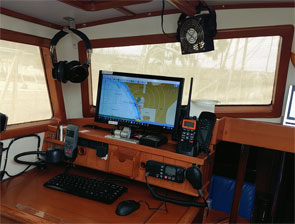 |
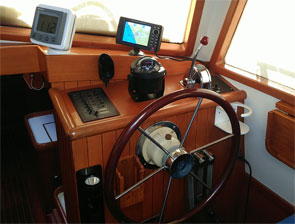 |
|
|
In the pilothouse, Active Transport has a nav station to port, left, and a steering station to starboard, right. |
||
If the spray was flying or if it was raining, we would just go on deck in a swimsuit to tend to sail trim or other details like the wind vane. If we got salty, a quick rinse with the cockpit shower fixed that problem, and a nice fluffy bath towel can dry a person a lot better than any method I have ever found for drying foulies.
Nav station with a view: The navigation station is one of the best features of the pilothouse layout as implemented on the Tayana 37. The traditional nav desk provides a safe, dry location for the laptop that handled all navigation and digital communications (SSB and Iridium phone). I installed an external monitor and keyboard so the laptop was never likely to be exposed to a rogue wave that might come in through the main hatch. I also had an identical (preconfigured) laptop stored in a Pelican case as a backup.
The navigation station is the perfect place to stand watch. The person on watch is out of the weather but with good visibility all around. They also have access to all of the navigation instruments and radios. The sailing instruments are repeated on a display in the pilothouse, and the electronic charts — complete with AIS data — are displayed on a monitor. The radar is also at the nav station and is mounted so that it can be flipped around and made visible from the cockpit.
Almost all of the electronic gear on the boat is inside the pilothouse, with the exception being the sailing instruments mounted in a NavPod on the cockpit steering pedestal. If I had it to do again, I would have put those instruments inside the pilothouse with the repeater in the cockpit. The only electronic failures I experienced were corroded switches in the cockpit instruments.
The benefits of having all of the navigation data available at a location where the helmsman also has good visibility around the horizon can’t be overemphasized.
I remember navigating through shifting channels behind Fraser Island in Queensland, Australia, where I had the charts on the monitor but could also see the channel markers that had been moved recently because of shifting sand.
The simultaneous view of the horizon and the electronic chart is incredibly helpful when trying to get a visual on AIS targets that show up on the chart.
Second steering station: Active Transport came with two steering stations. In the cockpit is a traditional Whitlock pedestal steering station that uses cables to connect the wheel with the quadrant. In the pilothouse is a Vetus hydraulic steering system that is connected to a massive hydraulic ram attached to a stainless-steel fixture bolted to the top of the quadrant.
This arrangement gave us two redundant steering systems. If a cable broke, the hydraulic steering would still work fine, which would allow us to put off the cable repair until conditions were suitable. Obviously this arrangement did not provide total redundancy, as any failure of the quadrant would have left both steering systems non-functional.
The internal steering station has not turned out to be as useful as I had originally anticipated. One reason for this is that I am basically of the opinion that steering by hand is fun for beginners, but when I’m sailing the boat I don’t want the distraction of steering and will almost always use the wind vane or autopilot except in high-traffic areas.
I had anticipated that the inside steering station would be very handy when docking since the visibility from the inside steering station was so good. The problem is that because of the small diameter of the wheel on the inside station, a lot of turns are required to move the rudder enough to execute a 90-degree turn when docking. So, I use the cockpit steering when docking.
One of the biggest advantages of the inside hydraulic steering is, oddly enough, the direct result of the biggest objection most sailors have to hydraulic steering: the lack of rudder feedback. You can’t feel the rudder and, unlike cable steering or a tiller, the rudder is held firmly in place when you take your hands off the wheel.
When sailing upwind, I can use the hydraulic steering to tweak the rudder angle until I find the sweet spot where the boat will sail itself. The rudder is held securely in place when the wheel is released. Active Transport can steer itself for hours upwind if the wind conditions are consistent, the rig is reasonably balanced and the appropriate rudder angle is locked in by the hydraulic steering.
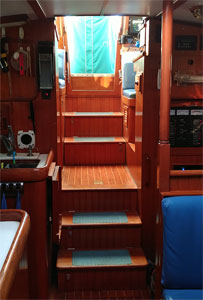 |
|
Two sets of wide steps provide access from below deck to the cockpit instead of a steep companionway ladder. |
The inside steering station also has a second engine control, which is valuable for redundancy.
Mobility: A lot of the boats I have sailed on had steep ladders from the cockpit to the cabin sole in the main cabin. Often those ladders were steep enough that it was necessary to back down the ladder when going below.
On Active Transport, the two sets of steps (from the cockpit and into the main cabin) allow easy access up and down. Plus, the steps on this pilothouse boat are much wider than on typical ladders. Footing is much more secure.
Engine access: When the floorboards of the pilothouse are removed, there is excellent access to the top of the engine and it is very easy to pull the engine up through the main hatch when that unpleasant task is necessary.
A few negatives
All boats are full of design compromises, and adding a pilothouse brings a few disadvantages. For me, the pros outweigh the cons.
Weight: The added weight of the pilothouse might be an issue for go-fast sailors, although we never found it to be responsible for any poor performance we could identify. To know if the weight is really an issue, it would be necessary to sail a lot of miles under a lot of different conditions on the same model of boat without a pilothouse. Certainly, the pilothouse weighs a lot more than a dodger.
Loss of space: When you have a pilothouse, you lose space in both the main cabin and the cockpit. To find space for the pilothouse, about 5 feet of combined cabin and/or cockpit space is sacrificed.
The loss of space in the main cabin is not as much as you might expect, since moving the navigation station to the pilothouse means you don’t have a navigation station in the main cabin. You also don’t have the engine cover taking up space in the main cabin.
The impact on the cockpit is a little bit more of a problem. On the pilothouse model, the cockpit is shorter than on the non-pilothouse version of the Tayana 37. This means someone as tall as I am (6 feet) can’t sleep comfortably in the cockpit.
There is also not enough room for a conventional (off-the-shelf) cockpit table that is usually attached to the pedestal.
Rigging compromises: Most of the rigging on my pilothouse boat is identical to that on the more common large-cockpit version. The dimensions of all the sails and spars are identical. The winches are well positioned in the shorter cockpit, and there is no problem finding fair leads for all the sheets.
The secondary winches are so close to the rail around the cockpit that there is not enough room for a full-sized winch handle, so an 8-inch handle is used on those winches. This is a problem unique to the pilothouse version of the boat, which is exacerbated by the fact that I had a stainless-steel rail built to go completely around the back of the boat aft of the lifeline gates.
The need to use shorter winch handles can be a problem when reefing a headsail in a blow. In those cases, I just lead the line from the secondary to the primary that is right in front of it, or across the cockpit to the lazy primary to get enough mechanical advantage to tame a flogging headsail.
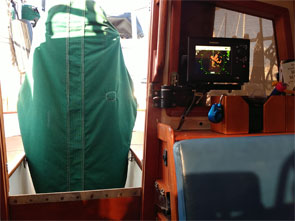 |
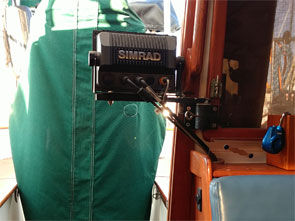 |
|
|
Lewis installed his radar display on an arm so it could be used both in the pilothouse and in the cockpit. |
||
The traveler on my boat is on top of the pilothouse, which I consider an advantage, as injuries are much less likely than with a traveler at deck level. But pulling the traveler adjustment lines up and out of the cam cleats is hard for shorter sailors with the traveler in this location.
The biggest disadvantage of the pilothouse, from a rigging perspective, is that there is no good way to lead halyards and reefing lines to the cockpit. I would have liked that ability but could never figure out a way to do it that would not have resulted in a nest of lines too high off the deck for safety. I ended up just biting the bullet and reefing at the mast. I put a big winch under the boom so I could reef quickly and easily, but I still had to go forward to reef the main.
Sail-handling compromises: Both headsails are installed on furlers so controlling, reefing and stowing those sails is exactly the same as it is on most sailboats.
There are both pros and cons associated with securing the doused main to the boom on my pilothouse boat. On one hand is the fact that I have to get on top of the pilothouse to secure the aft end of the main to the boom. If the seas are big, that additional height does not always make for a pleasant and stable work area. On the other hand, when on top of the pilothouse, I’m above the boom and not reaching up to it while trying to secure the sail. It’s easier to pull the sail up onto the boom and pull the full battens straight along the boom from above.
This problem is easily solved with lazy jacks and some sort of StackPack type of sail cover. I’m working on that now, but that change is more of a concession to my age than an essential modification.
Safety concern of big windows: The pilothouse has big windows, and that goes against the conventional wisdom that says it’s not a good idea to have large, vulnerable hatches and ports on a seagoing boat.
The glass in the windows on my boat seemed thick enough, so I did not worry too much about it. I did take the trouble to figure out which plywood locker covers from the cabin would be useful to close any broken pilothouse window openings, and I had a supply of self-tapping, hex-head screws handy in case I had to make such an emergency repair.
Big windows can let in heat in the tropics: This is true, but there are workarounds. I had a set of mesh covers made for the windows, and those do an incredible job of cutting down on the amount of sunlight that gets in the boat through the pilothouse windows while still allowing visibility to the outside.
When underway, those covers are removed because they do impact visibility — especially when there is a lot of spray flying and the little holes in the mesh get water drops in them. I also had two small hatches installed in the pilothouse roof when the boat was built so that the breeze could be directed into the pilothouse if there was no spray flying.
Sunlight through the pilothouse windows was never a big enough problem that I considered getting a deck awning for use at anchor.
My boat was purchased with a specific goal of circumnavigating in mind. I wanted the comfort and security provided by a pilothouse for long ocean passages with two people on board. The pilothouse boat turned out to be the right choice for my purposes, and I’m a little bit surprised that I did not see more of them in the anchorages all over the world.
Many of the pilothouse boats I did see were not really suitable for crossing oceans. They frequently had large and very tall pilothouses at deck level with sliding doors on the side rather than the compact design of the pilothouse on Active Transport that is snuggled down into the boat.
John Lewis, retired from the scientific instruments business, competed in the 1994 single-handed Transpac on his Nor’Sea 27 and later completed a six-year circumnavigation on board his Tayana 37, Active Transport.

